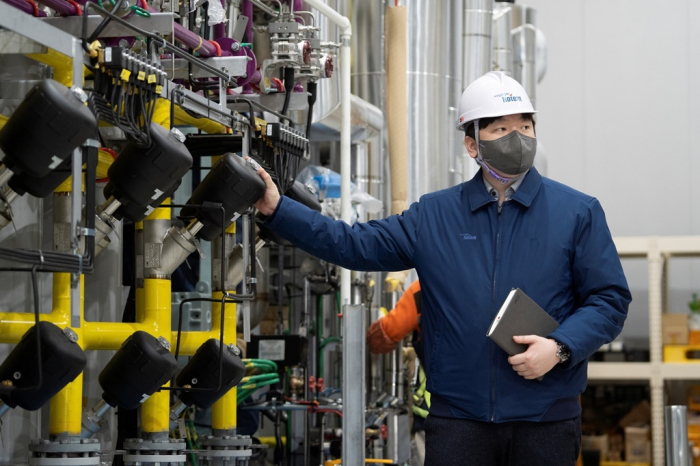Hydrogen economy
Hyundai Rotem to mass-produce hydrogen extractors
The extractor produces 640 kg of hydrogen a day, enough to fully charge 128 hydrogen-powered vehicles
By Jan 27, 2022 (Gmt+09:00)
2
Min read
Most Read
LG Chem to sell water filter business to Glenwood PE for $692 million


Kyobo Life poised to buy Japan’s SBI Group-owned savings bank


KT&G eyes overseas M&A after rejecting activist fund's offer


StockX in merger talks with Naver’s online reseller Kream


Mirae Asset to be named Korea Post’s core real estate fund operator



South Korea’s Hyundai Rotem is set to start in February mass production of hydrogen extractors that derive hydrogen from natural gas as it aims to meet the growing demand for carbon reduction at home and abroad.
Hyundai Rotem has made five hydrogen extractors so far since December 2020 when the plant commenced operations, according to industry sources on Wednesday. The factory with a capacity of 20 hydrogen extractors a year is scheduled to begin mass production from the next month.
The company, which delivered all of the hydrogen extractors to domestic customers, plans to export the device, given production requests from foreign companies.
“Demand is expected to increase in overseas markets such as Europe where hydrogen charging infrastructures are expanded,” said Joo Young-jin, Hyundai Rotem’s hydrogen business team leader.
Hyundai Rotem has been increasing investment in the hydrogen business as its top shareholder Hyundai Motor Co. aims to realize a hydrogen society by 2040, in which the clean energy source is harnessed not just for transportation but for wider sectors across industries.
ECO-FRIENDLY ENERGY FROM FOOD WASTE
Hyundai Rotem’s first hydrogen extractor was installed at a local food waste disposal site. The machine extracts hydrogen from biogas stemming from food waste, by separating methane from the gas and reacting it with water. The stinking gas turns into hydrogen of 99.995% purity through the device.
The company is working on research to use hydrogen extractors at farms and general waste disposal sites since livestock manure and waste also emit biogas.
Hyundai Rotem supplied the rest four units to hydrogen stations that charge hydrogen vehicles such as Hyundai Motor’s first dedicated fuel cell electric vehicle Nexo. One hydrogen extractor produces 640 kilograms of hydrogen a day, enough to fully charge 128 Nexos. The capacity is more than double of 200-300 kg that a hydrogen transport trailer can carry.
The company produces 90% of hydrogen extractors’ components such as heat exchangers and pressure swing adsorber (PSA), except consumable catalysts.
In addition, it is developing a small carbon capture device for the hydrogen extractor as the device, which was developed to reduce greenhouse gases, emits a small amount of carbon dioxide.
Separately, Hyundai Rotem is in a final stage in talks on liquid hydrogen charging station business with a local government. Liquid hydrogen is 800 times smaller than gaseous hydrogen in volume, so a tanker truck can transport more than 3,000 kg at once. The liquid hydrogen charging facilities are essential to realizing the hydrogen economy.
Hyundai Rotem is expanding mobile hydrogen refueling stations that are usually used by hydrogen-powered construction equipment and emergency vehicles in areas where charging infrastructures are insufficient.
Write to Hyung-Kyu Kim at khk@hankyung.com
Jongwoo Cheon edited this article.
More to Read
-
 Plastic recyclingHyundai Engineering to make hydrogen from plastic waste
Plastic recyclingHyundai Engineering to make hydrogen from plastic wasteDec 22, 2021 (Gmt+09:00)
1 Min read -
 Hydrogen economyHyundai Glovis to build hydrogen supply chain with Air Products
Hydrogen economyHyundai Glovis to build hydrogen supply chain with Air ProductsOct 19, 2021 (Gmt+09:00)
1 Min read -
 Hydrogen economyHyundai Motor to start hydrogen popularization in 2040
Hydrogen economyHyundai Motor to start hydrogen popularization in 2040Sep 22, 2021 (Gmt+09:00)
3 Min read -
 Hydrogen economyKorean conglomerates bet big on hydrogen, launch H2 council
Hydrogen economyKorean conglomerates bet big on hydrogen, launch H2 councilSep 08, 2021 (Gmt+09:00)
4 Min read -
 Hydrogen economyHyundai Motor’s Chung Euisun: Vision 2040 for hydrogen society
Hydrogen economyHyundai Motor’s Chung Euisun: Vision 2040 for hydrogen societySep 07, 2021 (Gmt+09:00)
3 Min read
Comment 0
LOG IN


